Cinquefoil Silverweed
Botanical name: Potentilla anserina
Family: Rose (Rosaceae)
Collectability: plentiful, common, widespread, good, weed
Main benefit
Mucous membranes and skin
Use - overview












Features and Identification
Habitat
Type: waste or grassy places
Distribution: throughout northern hemisphere
General
Growth type: herb
Cycle: perennial
Height: up to 30 cm
 Leaf
Leaf
Shape: pinnate
Texture: downy
Arrangement: basal rosette
Edge: toothed
Other: silvery underside
 Stem
Stem
Colour: may be dark red
Other: creeping, long runners root at leaf nodes
 Flower
Flower
Diameter: 15-20mm
Petals/sepals: 5
Arrangement: solitary on leaf stalk
When: May to August
Colour:
Type: waste or grassy places
Distribution: throughout northern hemisphere
General
Growth type: herb
Cycle: perennial
Height: up to 30 cm
 Leaf
LeafShape: pinnate
Texture: downy
Arrangement: basal rosette
Edge: toothed
Other: silvery underside
 Stem
StemColour: may be dark red
Other: creeping, long runners root at leaf nodes
 Flower
FlowerDiameter: 15-20mm
Petals/sepals: 5
Arrangement: solitary on leaf stalk
When: May to August
Colour:

Distribution Map

When Available?
 March to August
March to August all year
all year
Culinary Use
Flavour
Rating and Description:

 mild; older leaves are un-chewable raw
mild; older leaves are un-chewable raw
How to Consume
 raw, tea
raw, tea
 young shoots: raw
young shoots: raw
 raw, flour
raw, flour
Special preparation
 wash, scrape skin
wash, scrape skin
Used as ...
Plant: food
Rating and Description:

 mild; older leaves are un-chewable raw
mild; older leaves are un-chewable rawHow to Consume
 raw, tea
raw, tea young shoots: raw
young shoots: raw raw, flour
raw, flourSpecial preparation
 wash, scrape skin
wash, scrape skinUsed as ...
Plant: food
Medicinal Use
Action:
Plant: analgesic (bruised as poultice), antispasmodic, astringent (root strongest), diuretic, haemostatic, odontalgic, tonic
 anti-inflammatory, expectorant, sedative
anti-inflammatory, expectorant, sedative
May treat:
Plant: haemorrhoids, diarrhoea, menstrual pain, acid stomach, inflamed intestine; external: sore throat (gargle), ulcers
Plant: analgesic (bruised as poultice), antispasmodic, astringent (root strongest), diuretic, haemostatic, odontalgic, tonic
 anti-inflammatory, expectorant, sedative
anti-inflammatory, expectorant, sedativeMay treat:
Plant: haemorrhoids, diarrhoea, menstrual pain, acid stomach, inflamed intestine; external: sore throat (gargle), ulcers
Other Use
Plant: skin cleaning lotion
Collection, Storing and Notes
Collection
 June best for medicinal use
June best for medicinal use
 best late summer to autumn from large plants in loose soil
best late summer to autumn from large plants in loose soil
Drying
Dry in shade
 June best for medicinal use
June best for medicinal use best late summer to autumn from large plants in loose soil
best late summer to autumn from large plants in loose soilDrying
Dry in shade
Key
Plant parts:
 leaf
leaf
 stem or trunk
stem or trunk
 sap
sap
 root, bulb, tuber and other below ground parts
root, bulb, tuber and other below ground parts
 flower
flower
 fruit
fruit
 seed
seed
Use:
 culinary use
culinary use
 medicinal use
medicinal use
 household use
household use
Other:
 caution
caution
 leaf
leaf stem or trunk
stem or trunk sap
sap root, bulb, tuber and other below ground parts
root, bulb, tuber and other below ground parts flower
flower fruit
fruit seed
seedUse:
 culinary use
culinary use medicinal use
medicinal use household use
household useOther:
 caution
caution
Glossary
General Glossary
- pinnate: with series of leaflets on each side of central stalk
- analgesic: relieves pain
- anti-inflammatory: reduces inflammation of joints, injuries etc. (see also demulcent, emollient)
- antispasmodic: prevents or eases spasms or cramps
- astringent: causes localised contraction of blood vessels and tissue, reducing the flow of blood, mucus, diarrhoea etc.
- diuretic: increases secretion and elimination of urine
- expectorant: removes excess amount of mucus from respiratory system (see also decongestant)
- haemostatic: controls bleeding (see astringent)
- odontalgic: treats toothache (temporarily) and other problems of the teeth and gums
- sedative: calms the nervous system and reduces stress
- tonic: improves general health, bringing steady improvement




